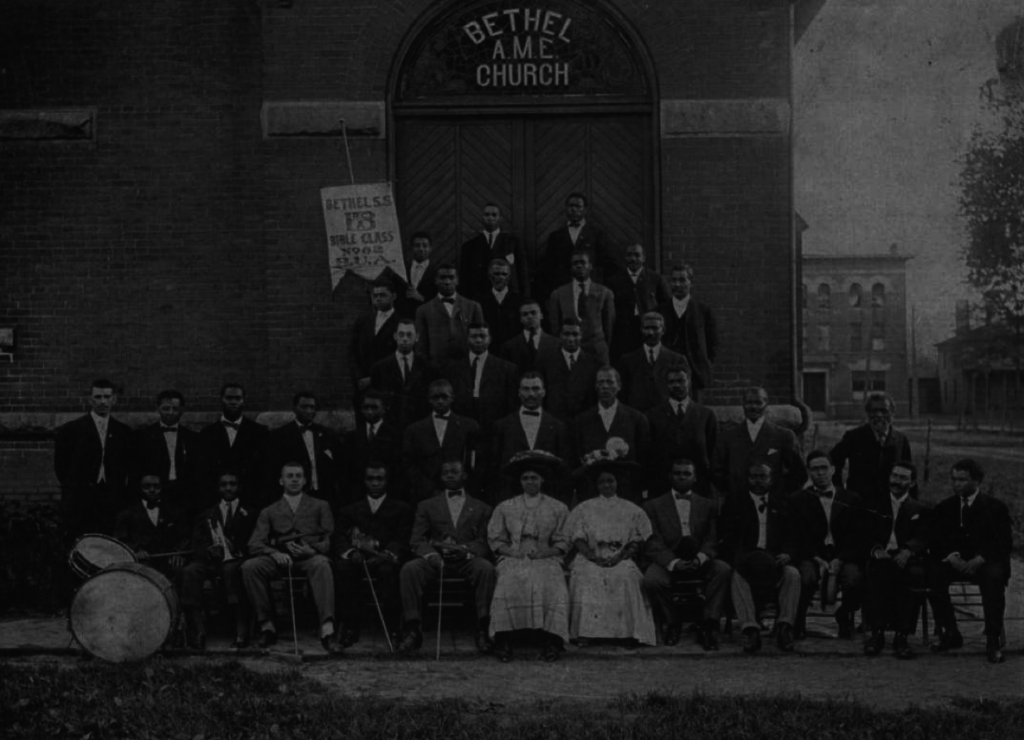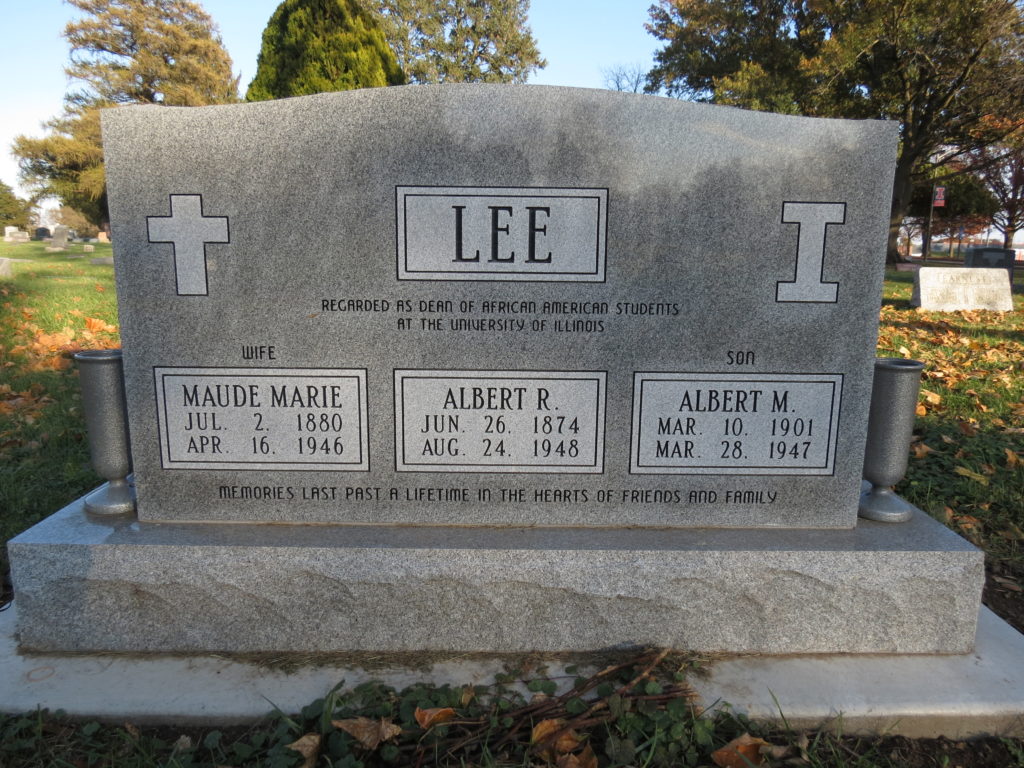The African American community in Urbana-Champaign and the University of Illinois community gathered this fall on several occasions to celebrate the life and contributions of an outstanding African American man: Albert R. Lee (1874-1948). Lee was the son of a slave, a church congregant in Bethel A.M.E. Church and the second African American employed by the University of Illinois, joining in 1895 as messenger in the President’s Office, and retiring in 1947 as Chief Clerk. Over years of service Lee made himself indispensable to the University, as he extended his tasks beyond clerical duties by counseling African American students and making right many classroom instances of racism. He is thus remembered as the unofficial dean of black students. A figure who resonated with diverse audiences, Mr. Lee held multiple other memberships: he was a registered Republican, an active Freemason, a local member of the N.A.A.C.P., and Sunday School District Superintendent. Lee worked cautiously toward closing the gap between an overwhelmingly white campus and local African Americans and out-of-state black folks wishing to get a college education at a school which, despite not offering them suitable (or any) housing accommodations or even access to campus restaurants, granted them admission and the promise of a future “without discrimination.”
Hosted by Lee’s beloved church and the University of Illinois, and funded by both institutions, the Lee family and private donors, memorial events recognized Lee’s racial work and, most notably, his early civil rights interventions on behalf of black students. On a sunny August morning at Mount Hope Cemetery on the U of I campus, we unveiled a new headstone for Lee, and for his wife, Maude Marie McCurdy, and their first-born son, Albert McCurdy Lee. In my years as a doctoral student at Illinois (2009-2013), I had tried multiple times to locate Lee’s resting place, until careful research and the kindness of staff members in Mount Hope allowed me to find Lee’s “general” location—a spot usually covered with fallen leaves which, when removed, revealed either a sunken stone or a broken foundation. Local lore suggests that racial unrest in the 1960s and subsequent vandalism of public places might explain the lack of a headstone. With most of his immediate family gone upon his death, the memory of Lee, sadly, faded. For years, however, anyone like myself doing research on African Americans locally had to explore the Lee papers, subsumed under U of I President Kinley’s archives—for years, those papers have been a well-stored marker, just as the unidentified broken foundation was in Mount Hope.
On the day of the unveiling, over 60 people attended, not including thirteen family members, who had traveled from Oklahoma, Texas and California to pay their respects. Among them, we had Ms. Maurine Yvonne Lee Sanders, granddaughter, and Mr. Forrest Albert Lee, grandson—two remaining siblings of the four Lee grandchildren. Prayers, readings and a cappella songs were beautifully rendered by university officials and Bethel Choir members. Associate Provost and Professor of Sociology, Dr. Assata Zerai most appropriately observed, as she opened the memorial: “Albert Lee could see a promised land, a university where students and employees would be judged not by their race, but by their brilliance, their character and their hard work and dedication to intellectual and social justice pursuits. He could see it when he looked out over the quad from the Henry Administration building.” As Lee’s scholar and biographer, I was allowed to join Ms. Yvonne and Mr. Forrest in the actual unveiling of Lee’s new headstone, a moment marked by great respect and anticipation from all attending. This marker, placed among church friends, is dignified in design and size, and thus matches Lee’s sober personality. More permanently, and quite deservingly, this headstone inscribes him in University and local history.
After the unveiling, we met for a luncheon with University Chancellor Dr. Robert J. Jones, other high university officials, Bethel congregants and the Lee family. The Champaign and Urbana mayors, Deborah Frank Feinen and Dianne Marlin, issued a joint proclamation during lunch, thus setting that date, August 31, as “Albert R. Lee Day” in both cities. Later in the afternoon, the Lee family was greeted by President Timothy L. Killeen, who graciously showed his guests a beautiful bronze plaque commemorating Lee, which is now placed in the President’s vestibule—a public area for other guests to notice, read, be informed, and remember the black man who, working closely with several Illinois Presidents, served unofficially, but very seriously, as the first dean of African American students. A nice and instructive fellowship ensued when the family visited the University Archives in the Main Library, where University Archivist Mr. William Maher and his staff had assembled two archival displays documenting notable pieces and writings of Lee’s. We were all moved when reading his letters on behalf of African American students and graduates; we were all impressed by Lee’s presence. This exhibit will remain open to the public until the end of the Fall semester 2018, during the Archives’ opening hours.

UIUC Unofficial Dean of African American Students Albert R. Lee’s Church in Champaign
The day ended with lyceum exercises held in the evening at Bethel A.M.E. Church—a monthly non-denominational Friday gathering, which Lee organized (1920-1930) for the practice of rhetorical exercises and citizenship. These meetings were the foremost spaces for public discourse, lectures, music and communal socializing. Alternating vocal and instrumental numbers with readings and recitations, community and University came together, as they might not have done before. While I had conceived these celebrations as most deserving closings to the Sesquicentennial celebrations at Illinois, I wish to embrace Dr. Jones’ most apt observations during the lyceum exercises: Celebrating Lee’s racial work, rather than closing these first 150 years, is actually opening new times of genuine disposition toward diversity, and an appreciation for black culture and citizenship efforts.
The Lee family stayed in town that Labor Day weekend—beyond the Friday memorials—visiting with Bethel members, attending Sunday services, taking in the African American neighborhood, but especially walking around Lee’s house on 605 North Walnut Street, Champaign. Remembering their summer visits to Lee’s house, Ms. Yvonne and Mr. Forrest (grandchildren), who at first had conflicting memories on the house’s location, were, after a few strolls, able to agree: “Yes, that white house, the one with the back loft addition, was in fact our grandparents’ house.” The original train tracks, once closer to the house—the precise difference that had kept them at odds—had been covered with cement and were no longer in use, and new tracks had been placed farther north of the house. Those old tracks were the ones Lee crossed over daily on his way to Henry Administration Building; those tracks were the ones students crossed over for meals and housing.
Two months after these memorials, three family members gladly returned to Champaign as Lee was posthumously given the Sankofa award at the Illinois 33rd Annual Diversity Breakfast on Friday, November 2. For the occasion I wrote a short documentary, “Albert R. Lee: ‘A Man of Substance, One of Illinois’ Finest Traditions,’” produced by the University of Illinois and shown during the breakfast, and whose extended version will be released in early Spring 2109. These events constitute a call to look back and uncover the histories of those lesser known spokespeople, who worked tirelessly for equality and became early beacons for civil rights locally.
Vanessa Rouillon is an Assistant Professor of Writing and Rhetoric at James Madison University, Harrisonburg, VA. She was a doctoral student at the University of Illinois at Urbana-Champaign, graduating in 2013 with a doctoral degree in English (Writing Studies). Dr. Rouillon is Albert R. Lee’s scholar and biographer.



